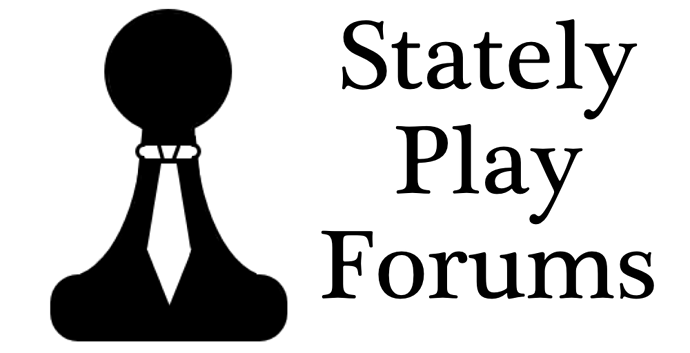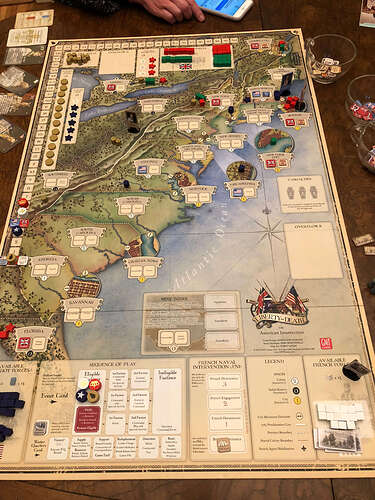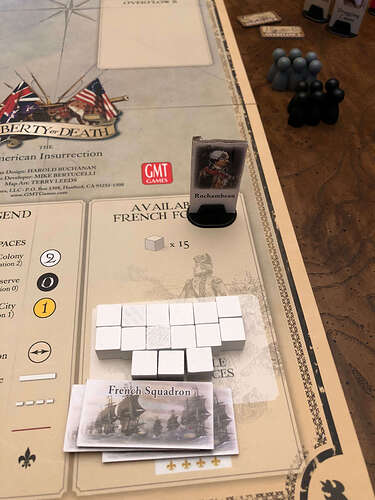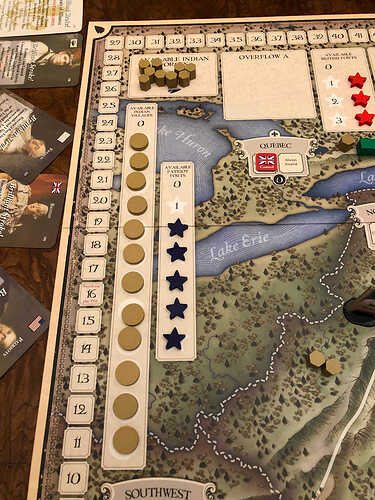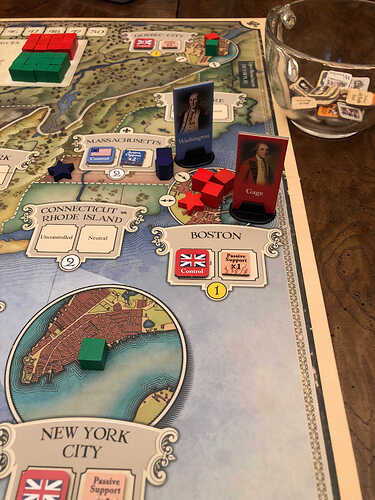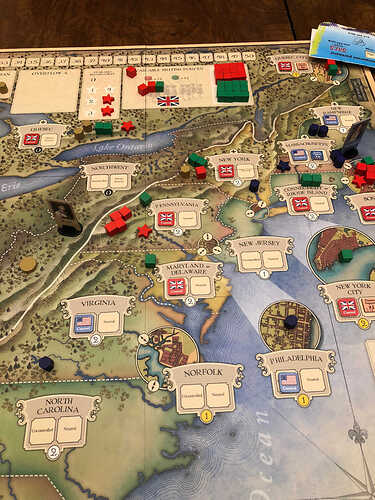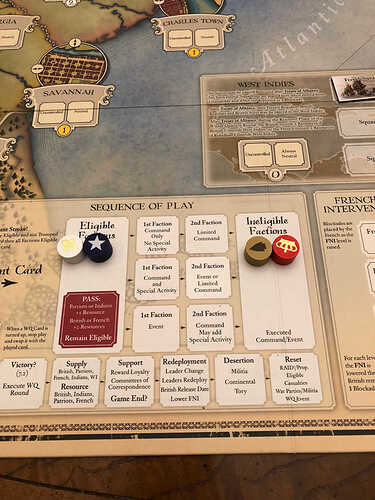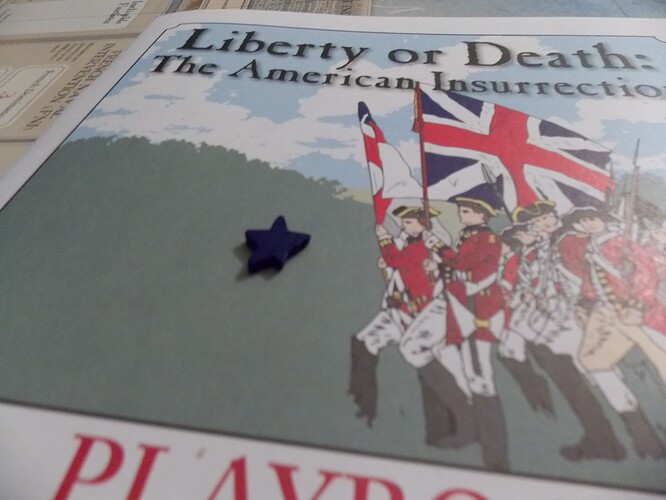Originally published at: http://statelyplay.com/2017/11/06/stately-sessions-liberty-or-death-turns-1-and-2/
Tabletop •
It’s commonly believed that the American Revolutionary War began on a wet Wednesday morning in northeastern Massachusetts in the year 1775. That may be true, but a much more fun version of it erupted on a cold November afternoon in Wisconsin, specifically (and much to my wife’s chagrin) on my dining room table. That’s when my latest foray into GMT Games’ fifth COIN game, Liberty or Death, began, leading to the following tale of military and political highs and lows.
The trip should have something for everyone. Old grognards can tell me where I misinterpreted the rules and how stupid I am for not covering my flank, while LoD newbs can read an alternate tale of the ARW and see if Liberty or Death seems like something they’d like to throw down on their own dining room table.
The game was played solitaire, with me playing the role of the Patriots, represented by the blue cubes and hex pieces on the board. The other three factions, French, British, and Native American, were played by using the included AI flowcharts, or “bots”. This is my first attempt at using the bots, so I will guarantee that errors were made. Feel free to point them out in the comments, but realize, too, that this game is quite rules heavy and that, while I’m sure I make mistakes, it’s still fun as all hell.
I’m playing the long scenario, “A people numerous and armed”, which covers the revolutionary war from 1775 through 1780.
The following session report will be told in a narrative style rather than just recalling what occurred each round. If I get more feedback that a tighter, gameplay-only retelling would be preferred, I can always switch later in the telling. This is going to take me a while to finish, and will probably run over the course of several weeks. As to not overwhelm, I will likely only cover one or two turns per post.
If you would like to follow along using the rules and player aids, you can find them here (these are all updated documents. My edition is a 1st edition, so the rules I’m going from might be a little different):
- Rulebook
- Playbook
- Battle Procedure
- Player Aids (contains all possible Actions and Special Activities)
- Errata
1775, Turn 1
[caption id="attachment_3562" align="aligncenter" width="3024"] Overall initial setup[/caption][caption id=“attachment_3563” align=“aligncenter” width=“3024”]
Before the game, Patriot Continentals (cubes) and militia (hexes) are ready to join the fray.[/caption][caption id=“attachment_3564” align=“aligncenter” width=“3024”]
In 1775 the French regulars and fleets are completely unavailable. Yes, Rochambeau is chewed up. Thank my dog.[/caption][caption id=“attachment_3565” align=“aligncenter” width=“3024”]
Native American warbands ready for action. They’ll need to build a lot of villages to win…[/caption][caption id=“attachment_3566” align=“aligncenter” width=“3024”]
The powderkeg[/caption]The War of Independence has begun in a flash of gunpowder in northeastern Massachusetts and, to be honest, fighting the beast that is the British Empire already seems like it might have been a bad decision. The British have a chokehold on Boston and New York Territory, while public sentiment in New York City is firmly learning towards the Tories. Quebec and Quebec City are firmly in British hands as well, and rumors have it that several Native tribes have joined the redcoats in the hopes of protecting their land via the Royal Proclamation of 1763. The lone Continental holdout is in western Massachusetts, where Gen. Washington leads the Continental Army, some underground militia, and a fort.
[caption id=“attachment_3567” align=“aligncenter” width=“212”]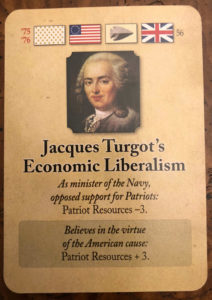 With FrenchBot helping out the Pats in New Hampshire, the Patriots decide to take the event and gain 3 resources.[/caption]
With FrenchBot helping out the Pats in New Hampshire, the Patriots decide to take the event and gain 3 resources.[/caption]
The French respond by mobilizing and adding underground militia to New Hampshire, changing the colony from Neutral to Colonial Control. They also begin moving unavailable fleets to the West Indies, indicating to the world that they are prepping for war.
Patriots follow the taking of New Hampshire by pleading their case to famed economist Jacques Turgot who believes in the virtue of the American cause and convinces Louis XVI to send more resources the Patriots’ way.
1775, Turn 2 (Patriots and French unavailable)
In order to keep the Native Americans out of the war, Congress invites the six nations, Mohawks, Oneidas, Tusscaroras, Onondagas, Cayugas, and Senecas, to Philadelphia and implores them to remain out of the conflict. The Native leaders are aware of the colonists desire to move west, however, and they take up hatchets for the King's troops. This adds underground warbands in Quebec and Southwest Territories, while the two existing warbands in the Northwest Territory build a village.[caption id=“attachment_3572” align=“aligncenter” width=“230”]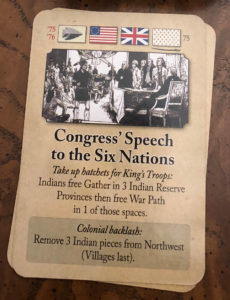 Well, that backfired.[/caption]
Well, that backfired.[/caption]
The British, using their naval supremacy, bring available reserves from England, dropping them in Pennsylvania. Doing so also increases the number of Tories willing to take up arms, with more popping up in Boston, Connecticut-Rhode Island, Maryland-Delaware, and Pennsylvania. Finally, a couple British Regulars and a Tory are put to work raising a new fort in the Pennsylvania wilderness.
[caption id=“attachment_3568” align=“aligncenter” width=“3024”]
New Indian village in NW Territory visible on the left, while the British Muster action’s results can be seen in PA and the rest of New England.[/caption]Thus, after 2 turns all four factions have had a chance to make a difference in the conflict. Tomorrow we’ll return with Turns 3 and 4, where we have to worry about the addition of Hessians to the war and see if the Tryon Plot can fail as badly in our game as it did in history.
As I mentioned earlier, please give feedback regarding the format of this session report. I have about 60 turns to get through, so I’ll be writing them for a while, and would rather put them in a format that more people enjoy or find useful. If you’d prefer it to be more “gamey” and get into the nuts and bolts of gameplay, let me know. I can do that, but was worried it would turn off folks who don’t have a copy of the game or are familiar with the rules.
[caption id=“attachment_3569” align=“aligncenter” width=“3024”]
After turn 2, the British and Native Americans are unavailable, while the French and Patriots begin to ponder the upcoming event, Hessians.[/caption][caption id=“attachment_3570” align=“aligncenter” width=“263”]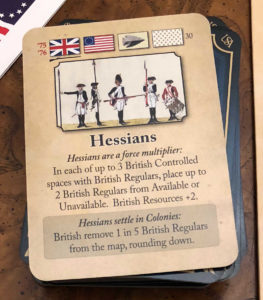 With the British out next turn, what will become of their Hessian allies?[/caption]
With the British out next turn, what will become of their Hessian allies?[/caption]
